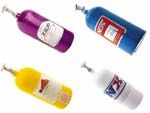
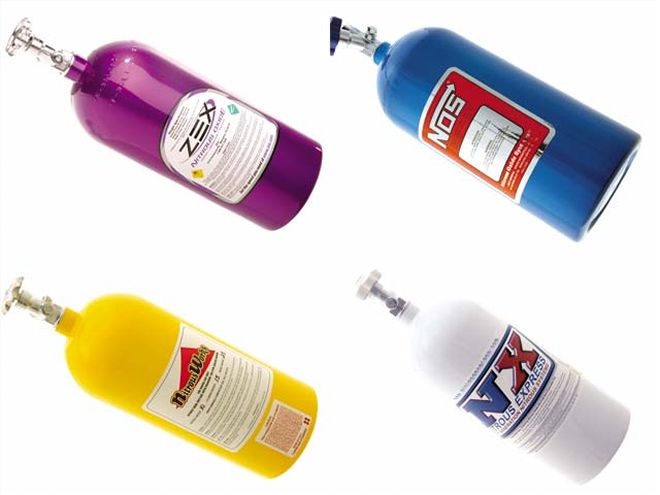
It wasn't too long ago that serious nitrous-oxide racers all used direct-port Fogger-style setups that inject nitrous oxide and fuel directly into each manifold runner. Plate systems--which spray nitrous and fuel out of a bar that mounts in a plate sandwiched between the carburetor and intake manifold--were relegated to 100-250hp street-racer applications. But racers started running so hard with direct-port systems that many sanctioning bodies outlawed them, figuring that plate systems had limited potential and would slow everybody down and restore class equilibrium.
Boy, were they wrong.
Racers and nitrous-system manufacturers went back to the drawing board, developing a whole new generation of 400-plus-horsepower plates that in many cases run as well as direct-port systems of a similar power level. For this article, HOT ROD contacted leading nitrous-oxide kit makers and hard-running plate nitrous competitors including Pat Musi and Scott Shafiroff. We found there is a general consensus on the tuning factors needed to make nitrous work, but the priority of the adjustment process and recommendations can vary between different manufacturers and individual tuner preference--so always begin by following the manufacturer's instructions!
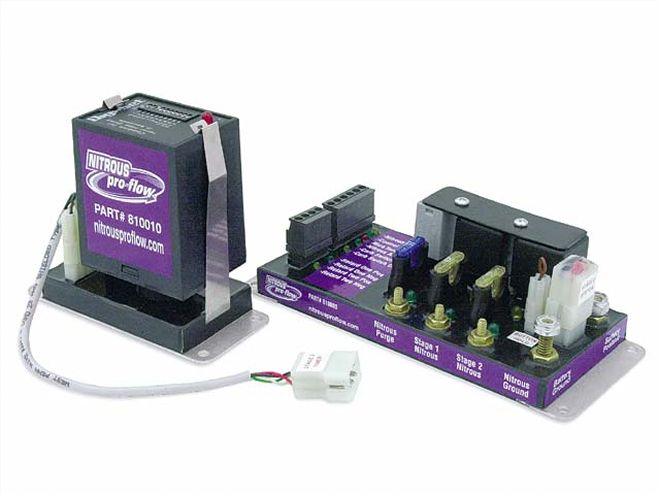 If wiring stuff scares you, you'll appreciate Nitrous Pro-Flow's integrated control unit, which includes the relays, controllers, and fuses for powering two nitrous stages and a purge unit. It has inputs available for an arming switch, WOT switch, and clutch or transbrake switch, and it needs only one battery-power input and one ground. The delay timer (left) can be used to activate the second stage.
If wiring stuff scares you, you'll appreciate Nitrous Pro-Flow's integrated control unit, which includes the relays, controllers, and fuses for powering two nitrous stages and a purge unit. It has inputs available for an arming switch, WOT switch, and clutch or transbrake switch, and it needs only one battery-power input and one ground. The delay timer (left) can be used to activate the second stage.
Plate nitrous setups are comprised of four major subsystems: the fuel-supply system, the nitrous-supply system, the electrical system, and the spray-plate. Each must be right, and all must work in harmony. We'll examine each, then go over some typical tuning guidelines.
The Nitrous Side
The nitrous side of the system consists of a bottle containing compressed nitrous oxide, a bottle outlet valve, feed lines, solenoids, and jets. As power levels increase, so must the capacity of these major components. Most manufacturers now supply at least a 15-pound bottle with large, purpose-built outlet valves, AN-6 or even -8 Teflon-core stainless steel braided feed hoses, and oversized solenoids. It's key to remember that jet size should be the minimum restriction in the system, not the bottle valve, hose id, or solenoid orifice, and to achieve maximum system efficiency and consistency, the nitrous needs to remain a liquid until it sprays out the jet. To obtain this goal, a nitrous system must start with its largest area at the cylinder and never increase in area to the point of injection. Avoid 90-degree bends, if possible.
The Fuel Side
When racers first began spraying nitrous, fuel pump and regulator technology wasn't what it is today. Racers initially used a separate fuel pump, supply lines, and regulator to supply the extra volume required by the fuel side of the nitrous system, because the primary fuel supply system couldn't keep up. Nowadays, many aftermarket pumps and regulators are more than capable of supplying the system's total fuel requirements, but there are certain advantages to retaining a separate fuel-supply system.
Everyone still uses a separate regulator for the nitrous fuel supply that mounts in parallel with the regulator for the carburetor fuel supply. An important tuning aid, this permits adjusting nitrous fuel pressure independently of carburetor fuel pressure.
Opinion differs on whether you should run one huge fuel pump or stay with two separate pumps. A single pump is less complex than two pumps and less taxing on the electrical system, but some insist separate pumps make it easier to troubleshoot nitrous-system problems and provide redundancy.
A minority of nitrous tuners, including Pat Musi and Bottle Blown Racing, advocate the use of high-pressure fuel-injection pumps with a return regulator. Because flow is proportional to the square root of fuel pressure, at carbureted fuel-pressure levels, small changes in fuel pressure produce significant changes in fuel flow rate. At fuel-injection fuel-pressure levels, the same-size pressure fluctuations produce much smaller flow-rate changes. Hence, use of higher pressures can both increase system stability and provide an even finer tuning aid. Most prepackaged systems are not calibrated for such high fuel pressures, so going this route requires retuning just about every aspect of the fuel and nitrous curve.
There are also those who advocate a separate fuel tank for the nitrous fuel supply. The gasoline side is under much lower pressure than the nitrous side, therefore the fuel side is more affected by high-G acceleration loads off-the-line. During the initial nitrous hit, there's potential for a slight (but potentially catastrophic) lag before the lower-pressure fuel side catches up with the higher-pressure nitrous side, especially if the fuel has to travel all the way from the typical rear-mount primary tank to the front of the vehicle, fighting gravity all the way. The solution is adding a small tank up front to supply the nitrous system's gas. This minimizes lag, because with the front-mount tank's fuel flowing rearward, the force of vehicle acceleration helps push the fuel in the proper direction. Obviously this makes a second fuel pump mandatory. As for the gas itself, nitrous guys run the highest octane gas they can afford. VP Racing's C16 or C23 seem to be the choice of most racers we talked to. Note that high-end fuels deteriorate faster in storage and are greatly affected by sunlight and U/V radiation.
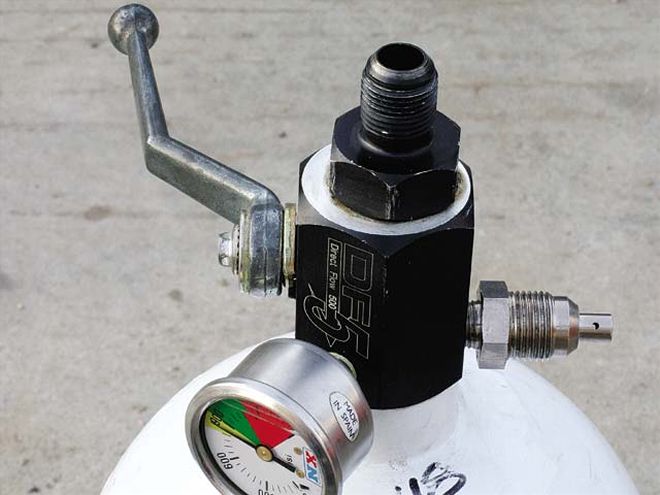 Bottle outlet valve size has increased right along with system flow potential. Commercial nitrous valves are long gone. Most still use overgrown right-angle valves, but the latest, highest-flowing valve of all is the giant, 1/2-inch-orifice, Direct Flow 500 inline valve offered by Nitrous Express.
Bottle outlet valve size has increased right along with system flow potential. Commercial nitrous valves are long gone. Most still use overgrown right-angle valves, but the latest, highest-flowing valve of all is the giant, 1/2-inch-orifice, Direct Flow 500 inline valve offered by Nitrous Express.
Primary Electrical
Drag-race electrical systems used to be pretty much an afterthought. Not anymore; not with nitrous. Some of the really big nitrous solenoids on today's Pro systems draw upward of 30 amps. Even moderately big solenoids take 15-20 amps. On multibar or multistage systems, you may have several big nitrous solenoids, multiple fuel solenoids, purge solenoids, delay boxes, assorted microswitches, a powerful ignition system, hungry fuel pumps, and transbrake-release solenoids. Yikes!
Depending on racer preference, this calls for either running a full charging system with an alternator, dual 16-volt batteries, or both (the ultimate fail-safe)! High-amp solenoids combined with low-amp delay boxes and microswitches make relays mandatory. This also means out with the butt connectors, at least on the high-amp side. You need to carefully solder critical joints and cover them with quality shrink-tubing, then pay careful attention to ground integrity. "It is useless to put a big power wire on something if the ground is not the same size and does not have as good a path back to the battery," says Speedtech. Adds Nitrous Express, "Shoddy wiring results in many damaged engines. I've seen some wiring jobs that would scare a rat!"Solenoids for nitrous are specially made with larger orifices and special seals. Most use either a Teflon or a neoprene seal. Neoprene seals better (good on the street, where you don't want any leakage), but Teflon is more rugged (better for racing, especially with progressive controllers).
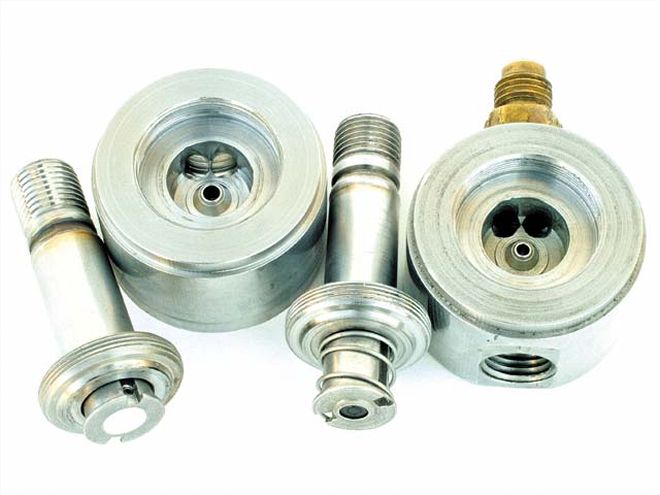 Huge nitrous solenoids draw up to 30 amps of current. Old industrial-size 1/8-inch main orifices are now as large as 5/16 inch. Available from NOS, BBR, and others, the bottom-feeder solenoid (left, compared to traditional, right) has its outlet on the bottom, eliminating one right-angle turn within the mechanism for improved flow. It also has a rugged Teflon seal.
Huge nitrous solenoids draw up to 30 amps of current. Old industrial-size 1/8-inch main orifices are now as large as 5/16 inch. Available from NOS, BBR, and others, the bottom-feeder solenoid (left, compared to traditional, right) has its outlet on the bottom, eliminating one right-angle turn within the mechanism for improved flow. It also has a rugged Teflon seal.
Pulsing
To soften the initial hit (both to manage power to the tires and cushion the engine shock) some type of delay scheme is typically used to establish an interval between launch (transbrake release) and full nitrous-system activation. This may include a delay box or other switch keyed to a time interval, a specific gear activation, and/or engine rpm. There are also progressive pulse-boxes available that gradually ramp up the nitrous from a preset starting percent to 100 percent over a defined, user-specified time period, but some shy away from this because the repeated, rapid on/off solenoid cycling used to accomplish this can shorten solenoid life. Jeff Prock at Advanced Nitrous Technologies also believes that rapid solenoid cycling can make the fuel side momentarily too rich.
Pulse advocates claim they make the hit much smoother. With the latest progressive controllers, the transition can be made so smooth "you can hardly hear the transition as it comes in," as Musi puts it, heaping particular praise on Edelbrock's unit. Pulse boxes work great to keep the front-end down, especially with short-wheelbase Ford Mustangs or factory four-link cars. On the other hand, NOS says that a window switch, which turns a circuit on and off at specified rpm points, "is a good idea for a stick-shift car. It lets you power-shift with confidence. If you set the engine rev limiter at 7,800 rpm, use the window switch to turn the nitrous off at 7,600--otherwise you'll get a big bang out the exhaust if you hit the rev limiter."
If going the pulse route, remember that if a solenoid sticks "open," it can ruin your whole day! The workaround is to use only the best-quality solenoids; add a separate, backup safety solenoid before the solenoid being cycled; and periodically replace the solenoids after so many hours of operation.
Staging
Rules permitting, there's also the option of running separate multiple nitrous stages. Each stage requires its own solenoid. Bring in the second stage as quickly as the car will take it and still keep the front-end down. Musi prefers the staged approach over 500 hp. "You will detonate if you turn 500 hp on at one time," he says.
However, Shafiroff cautions that stages can further complicate the tune-up because they may have different distribution characteristics. "When they mix together, it's like a gorilla." Although Shafiroff allows that staging can help limited-traction cars, on a manual-trans race car, he actually leads clutch release with a foot-switch on the clutch linkage. This eliminates any lag time. Traction problems are handled by adjusting the modern slipper clutch. With a transbrake car, Shafiroff fine-tunes the initial hit with ignition timing changes and delay boxes.
Remember, there's a fine line between cushioning the initial hit and losing time. Too much shock hurts parts and may break the tires loose, but on the other hand you want to reliably hit the engine and chassis with as much power as they can withstand, as improvements at the start of a run have a proportionally greater effect on reducing e.t. than improvements later in the run. As Nitrous Pro-Flow's Justin Elkes puts it, "Every number gained in the 60-foot is like two numbers gained on top."
Ignition System
The ignition system is joined at the hip to the primary electrical system. Nitrous' very high cylinder pressures require high-amp ignitions to light the fire. Fully digital ignitions like MSD's Digital 7 are preferred; not only is it easily tied into many of the same delay boxes and management devices as the nitrous system, but its advanced circuitry permits advancing and retarding the timing at any rpm in any increment. Timing can even be varied on individual cylinders.
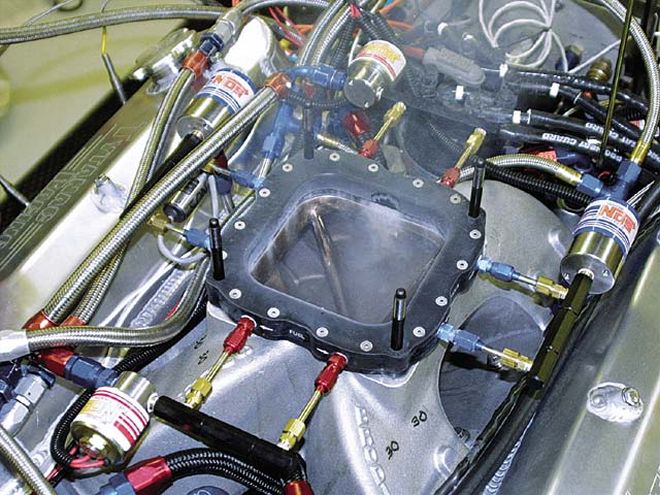 Several manufacturers are working with annular-discharge that fogs the nitrous and fuel mixture around the perimeter of the intake-manifold plenum. This provides better mixture distribution, allows for a bigger hit, and eliminates restrictions caused by the spray bars themselves.
Several manufacturers are working with annular-discharge that fogs the nitrous and fuel mixture around the perimeter of the intake-manifold plenum. This provides better mixture distribution, allows for a bigger hit, and eliminates restrictions caused by the spray bars themselves.
Dense, nitrous-rich mixtures require closing up spark-plug gaps as low as 0.018, (though 0.025-0.030 is more usual), and using only the best plug wires. As to plug heat range, figure on going at least one step colder for every 100hp increase over a 100hp baseline system. Don't use detonation-prone projected-tip plugs. Racers have had good luck with the special racing NGK, Autolite, and Champion plugs. Stay away from platinum, split electrode, or any "trick of the week" plug. Edelbrock points out, "Platinum plugs tend to break off the platinum tips with the first signs of even minor detonation." Another interesting tip, courtesy of Shafiroff, is that traditional large, full-body plugs are more durable and better able to resist heat than modern peanut plugs. Consider machining the head to accept a full-body 13/16-hex plug. At a minimum, don't run shorty plugs that have less porcelain on the back of the plug.
Plate, Manifold, Carb
Provided the integrity of internal engine parts can withstand the projected horsepower increase, the quality of nitrous and fuel distribution within the manifold is the governing factor on how much nitrous an engine can handle before problems occur. "Poor distribution is the number one cause of engine failures in plate nitrous system racing," says Speedtech. The higher the system's power level, the more critical plate design is to achieve optimum distribution. And plate design is inexorably linked to intake-manifold design. With a high-end plate system, just about everyone recommends a competition-style, single-plane, square-flange intake like an Edelbrock Victor, Holley Strip Dominator, or Dart. A dual-plane's two different plenum floor heights, center divider, and unequal runner lengths makes it difficult if not impossible to achieve optimum spray pattern distribution, particularly at over-200hp power-levels. "You need to be able to see all eight ports with the bars for optimum distribution," Pat Musi says. Others add to stay away from cloverleaf-shaped plenums; some claim the larger Dominator flange pattern offers more area to get the distribution right, even if the carb itself is still a 4150-style. Cautions Nitrous Supply, "The best nitrous system can get screwed up by a crappy intake."
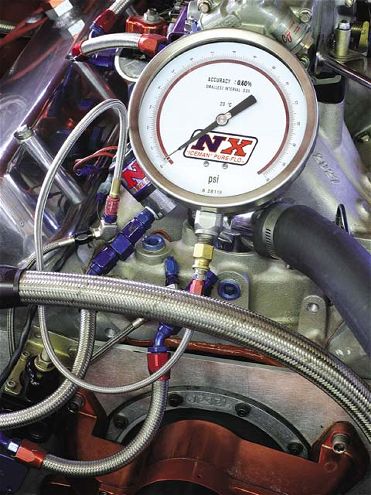 An advantage of a separate nitrous fuel supply is that it can be accurately dialed in by temporarily plumbing the fuel-solenoid outlet side back to the fuel reservoir or into a bucket (an extra capped-off line is seen at the arrow). The regulator can then be accurately adjusted without creep. Nitrous Express offers the huge and highly sensitive gauge.
An advantage of a separate nitrous fuel supply is that it can be accurately dialed in by temporarily plumbing the fuel-solenoid outlet side back to the fuel reservoir or into a bucket (an extra capped-off line is seen at the arrow). The regulator can then be accurately adjusted without creep. Nitrous Express offers the huge and highly sensitive gauge.
As for the carb, most recommend calibrating it for motor-only operation, relying on the nitrous system's own fuel supply to provide the proper amount of fuel when needed. But for race-only systems that will never be driven under motor-only conditions, there are some who recommend special carburetor calibration. This school holds that injecting nitrous and fuel into the plenum below the carburetor both effectively reduces the available plenum volume normally available for the carb's air/fuel mixture and also affects the metering signal. Be aware that the major carb changes required by this approach usually make the car virtually undriveable on the motor only.
The Tune-up
Potentially, there are at least seven things that can be varied to change the characteristics of a given nitrous system: the bottle pressure, the fuel pressure, the distance from the solenoids to the jets, the ignition timing, the fuel pressure, the nitrous jets, and the fuel jets. Of these, fuel pressure, jetting, and timing are the primary variables, with today's competitors usually trying to hold the other factors constant.
Increasing the distance from the solenoid to the jet softens the initial hit. Racers used to carry an assortment of different-length hoses to use as a tuning aid, but with today's sophisticated controllers and advanced clutch technology, this is no longer a common practice. On prepackaged systems, changing solenoid location and outlet line length can throw off the factory calibration.
Bottle Pressure
Raising nitrous-bottle pressure makes the system hit harder off the line at the expense of inconsistent taper-off on top. To avoid problems, most experts advocate sticking to the system manufacturer's recommended bottle operating pressures. Although this can vary slightly among different manufacturers, it's usually 900-1,000 psi. "The higher the bottle pressure, the greater the drop-off," says Nitrous Works' Doug Schriefer. "If you start out at 950 psi, you'll finish at 750; if you start out at 1,100, you'll finish at 600. The larger the bottle, the less the drop-off."
Whatever pressure you run, it should always be consistent, because it affects the rest of the tune-up. There is a direct correlation between bottle temperature and the bottle's internal pressure, so keeping the bottle at a specified temperature will also maintain the desired pressure. For example, if you maintain the bottle at 90-92 degrees F, there'll be about 950 psi at the start of the run. The pressure will drop during the run, but you should still have 880-900 out the back. Depending on local climate conditions, this may require a bottle blanket and electric heating device for warming the bottle, or a cold towel and ice to cool it.
Air/Fuel Ratio
With bottle pressure under control, the rest of the tune-up can be established. "Tuning for nitrous is no different than tuning any other power adder," says Nitrous Express. "When the air/fuel ratio is correct, the results are great; when the ratio is incorrect, the results are not so great." As to what constitutes correct A/F ratio, most recommend running slightly rich (generally, between 11.5-12.5:1), but agreement on this point is by no means universal, and some sources recommend going even richer under some circumstances. Musi believes in tailoring A/F ratios to the power level: "At 250 hp and under, you can run the same as the engine's air/fuel ratio. But at 450-500 hp I run 11.5:1 as a safety factor. Nitrous injection is not sequential like EFI, so when the valves are closed, the nitrous stacks up in the ports, runners, and plenum. The mixture may no longer be totally homogeneous."
Prock advocates adjusting the exact air/fuel ratio according to engine displacement. A 400hp kit delivers about the same 400hp boost on a 400ci engine as it does on a 600ci engine, but because the larger engine has much more total cylinder volume, the mass fraction of nitrous inducted into that engine as a proportion of that volume is less, so it is more easily absorbed. According to Prock, the big engine may be happy with an 11.5:1 A/F ratio, but you may have to go as rich as 10:1 on the smaller motor.
Speedtech notes that finding the exact A/F ratio to run can be somewhat tricky because nitrous carries its own oxygen. The ratio in effect becomes a variable of how much nitrous you put into the engine. Although exact recommendations vary among racers, Speedtech has found the following equation to work well as a starting point: Target A/F Ratio = [(engine hp / total hp) x 13] + [(nitrous hp / total hp) x 7] Actual A/F ratio tuning is accomplished with either a fairly costly high-end, wideband oxygen sensor, or (more commonly) by reading the spark plugs. Usually a light tan porcelain color on the plug is an indicator of the right timing. You need to read all eight plugs. If tuning with a wideband O2, ZEX cautions that the higher the ratio of nitrous power to engine power, the less accurate the O2 sensor will be. That's why most hard-core guys look at the plugs and exhaust-gas temperatures. Plugs don't lie.
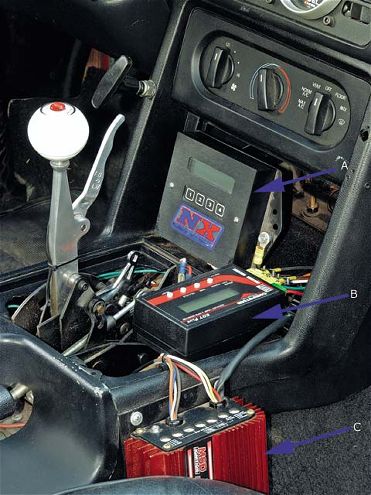 The electronics in Bobby Frye and Rick Snavely's Mustang are typical of many nitrous racers. Nitrous Express' Maximizer progressive controller (A) is reprogrammable from the cockpit, an exhaust-gas temp display (B) provides an A/F ratio check, and an MSD programmable multistep retard box (C) ties into an MSD7AL-2 box to manage spark and timing.
The electronics in Bobby Frye and Rick Snavely's Mustang are typical of many nitrous racers. Nitrous Express' Maximizer progressive controller (A) is reprogrammable from the cockpit, an exhaust-gas temp display (B) provides an A/F ratio check, and an MSD programmable multistep retard box (C) ties into an MSD7AL-2 box to manage spark and timing.
Fuel Pressure
The majority of racers fine-tune air/fuel ratio by changing the fuel pressure. Because the fuel side operates at much lower pressures than the nitrous side, very slight changes in fuel-system pressure can significantly alter system performance. Raising the fuel pressure richens the mixture; lowering the fuel pressure leans the mixture. It's also quick and easy out in the field, and you don't have to carry a bunch of different jets with you. Schriefer at Nitrous Works points out that "some sanctioning bodies have an orifice-size rule, so primary adjustments have to be made by varying fuel pressure." And Pat Musi adds, "I tune off fuel pressure once the jet split is established."
However, Shafiroff casts a dissenting voice: "Plates like low pressures. With modern nozzles, 6 psi is a mean starting point. You have about 1 psi to play with either way. Find out what it likes: Get the pressure right, then play with jetting."
The low-pressure fuel side is so sensitive to pressure variations that any changes should be made in 1/2- or even 1/4-psi increments. Most dead-head (non-return) pressure regulators tend to creep at idle, so it is common practice to test actual fuel pressure under simulated running conditions, or to use a data-logging computer that records the actual pressure during the run.
IGNITION Timing
Nitrous burns faster, so it requires less timing, but how much to take out initially and how fast to put some of it back in are key fine-tuning elements. "Timing is a great eliminator," Scott Shafiroff says. "It's the best way to control the system. Every outside thing affects the nitrous, affects how it loads the engine--vehicle weight, converter, clutch, gearing." The exact amount of timing to pull out varies for every combo. Start off conservatively, and put timing back in gradually. On a nitrous system, even a 1-degree change in advance can make a huge difference. A safe rule of thumb with good race gas is to pull out 1.5-2 degrees for every 50hp increase. "If you push timing to the ragged edge there's not much of a performance improvement, but the engine will be much more prone to detonation," says ZEX. "The timing can get down as low as 10 degrees with both stages on a multistage system activated," adds Pro-Flow.
Holley/NOS recommends taking a few degrees out before and after peak torque. Shafiroff cautions against trying to use timing as a crutch for trying to run too big a system. "It's better and safer on parts to run a smaller nitrous hit with just enough timing."
According to Prock, a big-block Chevy with conventional heads running a 400hp plate likes about 20-22 degrees of total advance. "You need to kick it further down at 4,000 rpm to 8-10 degrees then ramp it back up. The exact timing may vary per cylinder. For example, cylinders 2, 4, 6, and 8 tend to run hotter on a big-block Chevy." Torque converter-equipped cars may require even more retard.With the timing so retarded, the distributor rotor phasing gets out of whack. "One of the most overlooked contributors to nitrous engine failures and ignition problems when retarding timing electronically is rotor phasing," says Speedtech. "The rotor must always be in phase to the lowest timing that the engine will see during nitrous use. If you will be retarding more than 8 degrees electronically, we recommend that you use a crank trigger so that the rotor may be phased properly."
Jetting
Finally, there are the nitrous and fuel jets. On prepackaged systems, it is standard practice to run the jet combos recommended by the system manufacturer for the power level desired. If you're not making the power you think you should, or if you want to tweak a rules-restricted system, majority opinion says you should play with the jets only as a last resort once the car fails to respond to fuel-pressure and timing changes. An exception is Holley/NOS, which recommends leaving pressure and fuel jets alone. "Keep fuel pressure at 53/4-61/4 psi, and just change the nitrous jet" to compensate for a bad-air day. The nitrous side pressure is so much higher than the fuel side that going up or down one nitrous jet size is a much finer (and safer) tuning tool than changing fuel jets. However, Pro Flow disagrees, recommending size changes to the fuel jet in the nitrous system to get the engine to perform at its best. "It's just like jetting a carb." Either way, be sure to keep careful records of any changes and be damn sure to carefully read those plugs! Nitrous Supply concludes, "If you have to change jets more than two sizes, look for a restriction somewhere else in the system."
Failure Modes
The two most common nitrous-motor catastrophic failures are blown head gaskets or burnt pistons. A blown gasket can be hard to run down because it can be caused by either the wrong air/fuel ratio or detonation (or both, since the two can be related). If you just treat the symptom with improved gasket sealing, there's a good chance the next failure will be with the pistons.
Piston failures are easier to diagnose. You'd think going too rich is safer than too lean, but if liquid fuel trickles down past the rings, the resulting distress can lift the rings upward. As Nitrous Express puts it, "Many nitrous failures are caused by running the engine excessively rich. Contrary to popular belief, richer is not necessarily safer."
On the other hand, burning a trough down through the rings into the skirt usually means you are both too rich and have too much timing in that cylinder. "But if you burn a hole through the top of the piston, you are running too lean. If you start the burn and there's nothing left to burn, everything's gone--you'll just burn the aluminum," adds Musi.
Dialing in a sophisticated nitrous system requires a patient, methodical approach. "Do not get greedy," says Holley/ NOS. "When you're going from a compressed liquid to a gas, the density changes constantly, and you don't have as much control as you'd like to," says Shafiroff. Go conservative on timing, be careful not to run too rich or too lean, use really cold plugs, and learn how to read the plugs. Institute a nitrous-system maintenance schedule. And hit the nitrous at the top of each gear, not the bottom. If building from scratch, design for high rpm--it's easier on a nitrous motor.
Nitrous is not a crutch that bulks up otherwise weak engines or marginal tune-ups--it only magnifies existing problems. Get the engine running right on the motor before you hit the bottle. Then dial-in the nitrous oxide on one of the recommended lower-power tune-ups. If it doesn't perform as it should, don't step up to the next level until you've sorted out any existing problems. Change only one thing at a time. Don't be afraid to ask fellow racers or tech-support personnel for help. As Speedtech puts it, "Take the time to listen to what your engine is trying to tell you. They all talk; you just have to listen." HRM
Great Plates
Each manufacturer has its own ideas how to achieve optimum distribution. Key characteristics that vary according to different theories include the amount of holes and their angles, spray-bar configuration and number, and whether the fuel and nitrous should be introduced from opposite sides or the same side. Some niche nitrous suppliers actually go so far as to custom-tailor plate and spray-bar characteristics to the individual engine combination and system power level, as opposed to supplying a generic, "one size fits all" solution. The end goal is to break up the fuel introduced into the manifold plenum into the smallest particles possible to aid in drying the fuel before it reaches the combustion chamber, making it easier to combust and more efficient. Here are a few of the newest options.